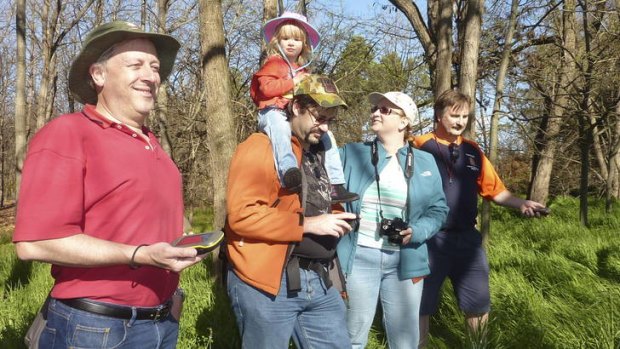
Tankengine, Eynowd (with Tiger-Monkey on his shoulders), Dvixen and Mtrax on the hunt for a geocache in Weston ParkCredit: Tim the Yowie Man
It has to be one of the more unusual emails to have landed in my inbox. ''Tim, while walking around Lake Burley Griffin near the Lindsay Pryor National Arboretum (opposite the Governor-General's residence) yesterday we came across some sort of time capsule. It was underneath a small boulder near the water's edge and was probably washed down from a Queanbeyan park during the floods earlier in the year. It's the only boulder along that stretch of shoreline so you can't miss it. I didn't want to touch it but thought you should investigate!'' demanded the semi-anonymous missive from Jenny (no last name given) of Ainslie.
Now while I receive more than my fair share of odd requests, I must say I've never before been asked to check out a displaced time capsule. Heck, if I find it, what am I supposed to do? No doubt, I'll probably have to smash it open to discover who it belongs to. But isn't it bad luck to prematurely open a time capsule?
With these questions racing through my mind, earlier in the week, armed with a camera, an open mind and a tomahawk (to break open the capsule if its origins can't be identified from the exterior), I set off to solve the mystery. I'm not sure why so many people flock to the National Arboretum across the road where the saplings are only a few metres high, when here in the Lindsay Pryor National Arboretum there are groves of towering exotic and native trees (more than 50 different species planted by Pryor from 1954 to 1957) to wander among and expansive lakeside grassy knolls on which to throw a picnic blanket or kick a footy. However, I must say I'm glad no one is here today - for the sight of a man in a tattered Akubra fossicking through debris on water's edge with a tomahawk in tow wouldn't exactly instil comfort in the hearts of picnicking families.
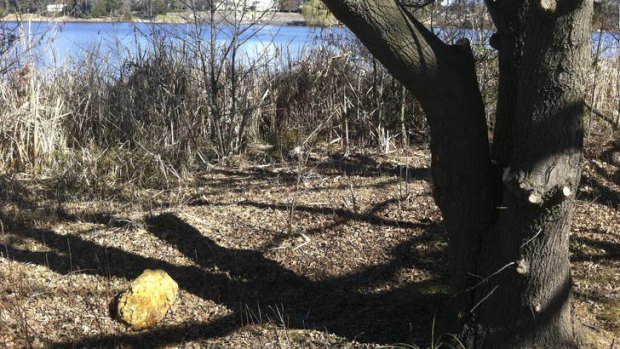
The boulder-like cache in Lindsay Pryor Arboretum.Credit: Tim the Yowie Man
After rummaging through reeds for a good 20 minutes (the recent forced drop in the lake's level to undertake work on Scrivener Dam has exposed a lot of debris), I finally find the boulder in question near the western shoreline, under a tree.
As I approach the orange-coloured rock, it suddenly dawns on me; I am alone, acting on a partly-anonymous tip-off, investigating a somewhat suspicious object within no one else within cooee. I didn't even inform Mrs Yowie Man I was coming here. Mmm. What if it's a booby trap? Maybe it's part of an elaborate attempt to lure me here and at any moment a masked assailant will jump out from behind the tree, knock me on the head and run off with my wallet or, worse still, pluck my prized Akubra off my noggin?
With this in mind, I creep towards to boulder (it's more a large rock), looking nervously over my shoulder and straining my ears, listening intently for any ticking noises. But for a squawking cockatoo feasting on a conifer nearby, it's all quiet on the western front. At least it's not a bomb. Well, not a ticking one anyway.
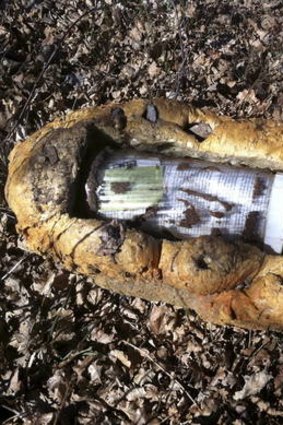
Inside the time capsule-cum-cache.Credit: Tim the Yowie Man
I'm also in full view of the GG's residence where a guard has no doubt had me under surveillance through binoculars for the past half an hour. ''There's some clown acting suspiciously and wielding a tomahawk over in the park,'' is probably his CB radio call to his mates at the AFP.
Keen to get to the bottom of this mystery time capsule before a carload of cops bundle me off to the city watch house, I approach the rock and give it a hefty kick. It moves quite easily and rolls several metres away. More importantly, it doesn't blow up. In fact, it turns out it's not a rock at all - rather a carefully crafted chunk of foam embedded with pebbles to make it resemble a small boulder.
Closer inspection reveals that wedged into a cavity in its underbelly is a long plastic cylinder. Perhaps my informant's elusive time capsule? Cautiously, I unscrew the lid - a number of little kids toys falls out along with a small book. There's no sign of a Rubik's Cube, no yo-yo, no floppy disk and no lists of who had crushes on whom in Queanbeyan in 1982. In fact it's not even a time capsule - an explanatory note eventually falls out that detailing purpose. It reads, ''This is a geocache, if you have found it by accident, please leave it as you found it. For more information, www.geocaching.com.''
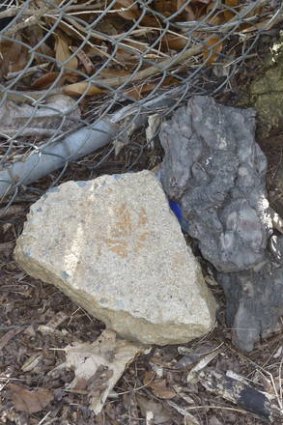
Found it! Weston Park's Traumatised Tree III geocache lies under this rock in a bluer container!Credit: Tim the Yowie Man
I've heard of geocaching a few times - it's a modern day twist on a scavenger hunt where people (cachers) armed with a GPS-enable device go in search of hidden objects (caches) guided by co-ordinates and sometimes clues downloaded from a website - but never really handled a cache before. I immediately advise Jenny that her time capsule is actually a geocache and log onto the website to find out more about geocaching. Intrigued regarding the enormity of the sport (there are about two million caches listed worldwide on the site!), I fire off an email to a local cacher, Paul Wilson, or MTRAX as fellow cachers refer to him, and ask if he can unravel this ultra-modern version of hide 'n' seek to me. He explains the cache I've uncovered is a part of a complex puzzle cache and offers to take me to a more traditional cache to explain more about the world of geocaching. We agree to meet me at an appropriately secret place in Weston Park the next day.
On arrival, I'm surprised to see he's brought along some caching mates (either that or he's heard of my tomahawk wielding tendencies and called them in as back up). There's Thomas Schulze (Tankengine), Geoff Skellams (Eynowd), Angela Skellams (Dvixen) and their two-year-old daughter Rhiann Skellams (Tiger-Monkey).
''It's a sport for anyone - and there are different difficulty gradings for each cache so you can make it as serious as you like,'' Dvixen says. MTRAX then explains that there are about 1800 caches in the ACT from easy family-friendly ones around city parks to others on remote peaks in the Brindabellas.
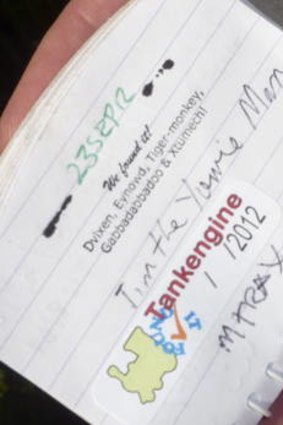
The signed log book at Tankengine's Traumatised Tree III.Credit: Tim the Yowie Man
''Today, we're in search of a traditional cache, Traumatised Tree III (TTIII) which is the original geocache type consisting of, at minimum, a container and a log book,'' Tankengine says, adding, it's so named ''because the first cache here was bulldozed, the second seemed perpetually underwater, so maybe it's third time lucky.'' Everyone then dials up their smartphones to show a description of our target - it reads ''at this spot you will find yet another traumatised tree, which although alive and well, I am sure is not overly happy with its predicament! Have a close look at the tree, amazing.''
While it's a non-contact sport (well usually, there are reports of a bit of push and shove to try and reach a cache first), it definitely has a competitive element. In a similar vein to twitchers who can tell you how many different species of birds they spotted in the world, and many, the day, time and location of each sighting, serious geocachers can rattle of their cache count and history. With a combined total of almost 10,000 caches between them (including 5000 from Tankengine alone) I'm in pretty good hands to find TTIII.
And sure enough, after just 15 minutes of traipsing through Weston Park (watch out for the swooping magpies near the back of the government nursery), MTRAX's GPS says we are only 16 metres from our hidden treasure. Little Tiger-Monkey's eyes light up and she runs towards a piece of bark lying underneath a tree. She rips off the bark and to her glee reveals the concealed cache.
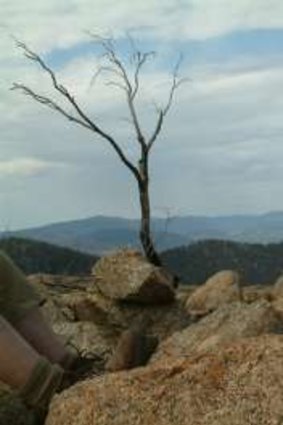
Burnt cache atop Booroomba Rocks in Namadgi National ParkCredit: Nigel Chauncy
Tiger-Monkey peers inside and swaps a small trinket (it's an unwritten rule that if you take one of the pieces of ''treasure'' you replace it with something of similar value), while the other cachers line up to stamp their personalised calling cards in the log book. Being a muggle (non-cacher) I don't have a stamp. ''Lucky there is a pen,'' Tankengine says as he hands it to me, adding with a grin, ''You're lucky, some people on reaching hard-to-find caches discover they've forgotten their stamp and the pen doesn't work and resort to signing in blood.''
Like pirates guarding their pillaged bounty, we gather around the uncovered cache and chat about some of the intricacies of this sport, including how addictive it can be. ''As it's a global sport, no matter where I go, if I'm going away for a weekend I'll check to see what caches I can tick off while I'm there,'' says MTRAX, who admits to planning his holidays around the location of caches.
As an added dimension, some cachers leave trackable tags or coins in caches. ''The item becomes a virtual hitchhiker that is carried from cache to cache in the real world and you can follow its progress online,'' says Dvixen, who has even set up her own store, geowhat.com.au, peddling such trackables and other geocaching paraphernalia.
''But it's dangerous to assume if you log on one day and your trackable is in a particular cache that it will be there when you arrive,'' says MTRAX, who bemoans, ''I once logged-on and discovered that one of my trackables was in Yorkshire but by the time I got there to try and get it back, it was in Japan!''
As with any sport, geocaching does come with an element of danger. First there are the risks with actually trying to find a cache and it's not always as innocuous as a swooping magpie. ''I once put my hand down a hole trying to pull out a cache only to be bitten on the finger by a nasty little possum,'' Tankengine says. ''Then there's the possibility of a cache going missing. For example, a cache can be muggled [a non-cacher removes it] and, in extreme cases, destroyed or removed by police and bomb squads [add to that list tomahawk-wielding columnists!] under the belief that the cache is actually a suspicious package,'' MTRAX says.
''Oh and some can come to grief in other ways,'' Eynowd adds. For safety reasons, local cacher Nigel Chauncy (alias: 2 Leg Drive) had to wait several months after the 2003 bushfires before being able to check on his favourite cache near the top of Booroomba Rocks in Namadgi National Park. When he eventually reached the cache, concealed in a large plastic Tupperware container, he discovered that although parts of the cache had melted, the contents - ironically including a candle and some matches - were safe.
Back at the car, I realise I've only scratched the surface of this international phenomenon, which now has more than five million participants worldwide. I also realise I was way too focussed on the thrill of the chase in finding TTIII that I forgot to gaze up its trunk to discover ''its unusual predicament''.
Bummer. However, now that I'm hooked. I guess it's a good reason to return to this cache. And who knows, I might even make up a special ''Tim the Yowie Man was here'' sticker (in blood red to boot) to leave as my calling card.
Oh, and Tankengine beware - I only have another 5001 caches to catch up to you.
FACT FILE
More: For all you need to know about this fun, family-friendly activity, see geocaching.com.
Crazy cacher: Wealthy Texan geocacher Richard Garriott de Cayeux (alias: Lord British) is responsible for some of the hardest-to-reach caches in the world. He's hidden one in the International Space Station and plans place his next cache 3750 metres under the North Atlantic Ocean at the final resting place of the RMS Titanic.
Unusual caches: If you know of any quirky or unusual caches hidden around Canberra, please let me know. timtheyowieman@bigpond.com
Sign up for the Traveller newsletter
The latest travel news, tips and inspiration delivered to your inbox. Sign up now.